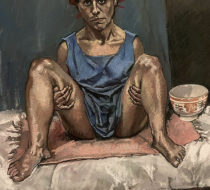Abortion Series Favorite
In 1998 Portuguese born artist Paula Rego created a series of work entitled Untitled. The Abortion Pastels. Rego created her work in response to a referendum to legalise abortion in Portugal, which was very narrowly defeated. Each canvas depicted the image of a woman undergoing an unsafe abortion. When the series was exhibited in the Portuguese capital, Lisbon, Rego recalled the whispered secrets of women in the gallery while looking at her artworks. In turn, after being exhibited, her work is stated to have been integral in changing public opinion. It’s a powerful example of feminist protest art impacting on local and national views.
“It highlights the fear and pain and danger of an illegal abortion, which is what desperate women have always resorted to. It’s very wrong to criminalise women on top of everything else. Making abortions illegal is forcing women to the backstreet solution. I’m doing what I can with my work but both men and women need to stand up to this. It affects men too. You don’t get pregnant on your own do you?” – Paula Rego.
Abortion laws in Portugal were liberalised to a greater extent on April 10, 2007.
From Scotland's National Galleries Website:
In 1998 a referendum to leagalise abortion in Portugal failed. In response, Portuguese artist, Paula Rego, created the Abortion Series (1998), a selection of paintings which draws attention to the dangers of making abortion illegal. The effect of the series was so powerful that it has been credited with helping sway public opinion to form a second referendum in 2007.
Professor Sharon Cameron is a Consultant Gynaecologist, and Lead for sexual health services NHS Lothian, and Co-director of Clinical effectiveness Unit of Faculty of Sexual and Reproductive healthcare UK. Here, she dicusses the importance of this series.
As a gynaecologist I provide care for women throughout their lives and from puberty to beyond menopause. This includes helping women to become pregnant and also providing care when women have an unintended or unwanted pregnancy and so Rego's abortion series particularly marked me. The paintings of women about to undergo a ‘backstreet’ abortion at a time/ place when abortion was illegal. The women are alone. A young schoolgirl, an older woman, possibly already a mother. Fear, shame, defiance or pain can be seen in their face. The bucket beside them that will soon be full of blood. The woman in the painting may die, she may suffer severe complications. Yet this is all preventable with safe, legal abortion.
These powerful paintings are credited with having helped bring about legalisation of abortion and with it, safe abortion in Portugal. In countries where abortion is legal, it is an extremely safe procedure and increasingly it is performed at an early stage as a medical method that involves taking two types of medication. Safe abortion saves women’s lives and prevents the horrific consequences of unsafe procedures.
Yet, tragically almost half (25 million) of the estimated 56 million abortions that take place in the world each year are conducted under unsafe conditions, in countries where abortion is illegal or highly restricted. These unsafe abortions are a major cause of maternal death and disability. Most of these are in developing countries. It is estimated that unsafe abortion results in the deaths of between 22–31,000 women every year. Deaths which are preventable through safe legal abortion.
Restricting a woman’s access to abortion does not prevent abortion but simply leads to more unsafe abortions.
Liberalising abortion laws around the world is essential for safe abortion but needs to be accompanied by health policies that support implementation of the law, increase the availability of trained providers, and work to remove the stigma of abortion in our societies.
Rego decided to represent the subject quite clinically, as she did not want the pictures to be melodramatic.
'I tried to do full frontal but I didn't want to show blood, gore or anything to sicken, because people wouldn't look at it then. And what you want to do is make people look, make pretty colours and make it agreeable, and in that way make people look at life.'
At the same time, she intended to reveal aspects of abortion that are rarely spoken about, in particular the effect of the procedure on women themselves.
'This is another thing that is not in our culture, which I show in the picture of the girl facing you with her legs up, Lila. There was one point where she looked really triumphant and then something happened in the picture, as if she had been slapped across the face, you see. And then she is being humiliated and yet she is triumphant, completely triumphant. So they are not pictures of victims.'








